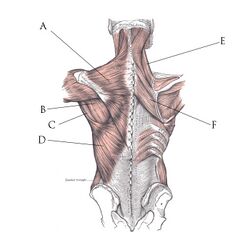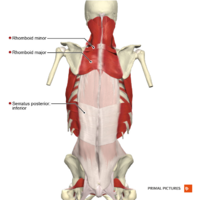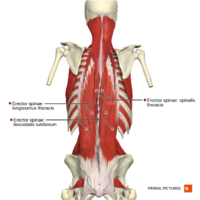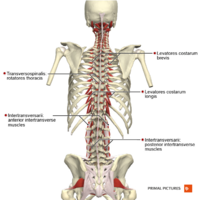Back Muscles
Original Editor - Lucinda hampton
Top Contributors - Lucinda hampton and Kim Jackson
Introduction[edit | edit source]
There are three major groups of back muscles:
- Superficial: attached to the shoulder girdle
- Intermediate: attached to the posterior thorax
- Deep: attached to the vertebral column, also known as the intrinsic muscle group[1]
These groups serve to allow: flexion/extension, rotation, and side bending of the back; movement of the limbs; locomotor function; and assistance in the respiratory effort[2].
Generalized back pain is a common presenting symptom for patients. The underlying etiology of the pain commonly traces to a strain of the skeletal muscle[2].
Additional terminology
- The superficial and intermediate muscle groups (or extrinsic muscles) are also called immigrant muscles, since they actually represent muscles of the upper limb that have migrated to the back during fetal development.
- The deep/intrinsic back muscles, are also called true back muscles. They are located deep to the extrinsic muscles, being separated from them by the thoracolumbar fascia[3].
Superficial Group[edit | edit source]
The first category is the superficial back muscles. These muscles are located posteriorly on the back, whose function is to move the scapula.. The superficial muscles include[2]:
- Trapezius
- Latissimus dorsi
- Levator scapulae
- Rhomboids
Each of the muscles in this group are fairly large and superficial and correctly locating any one of them by palpation is easily accomplished[4].
Intermediate Muscles[edit | edit source]
The intermediate group contains two muscles:
These muscles run from the vertebral column to the ribcage, and assist with elevating and depressing the ribs. They are thought to have a slight respiratory function[5].
Deep/Intrinsic Muscles[edit | edit source]
These muscles are responsible for the motion of the axial skeleton. The main movements are flexion/extension, side bending, and rotation. This group further subdivides into several categories in the back and neck. The main muscle groups in the intrinsic muscle group are the erector spinae group and the transversospinalis group.
Resources[edit | edit source]
- bulleted list
- x
or
- numbered list
- x
References[edit | edit source]
- ↑ Geeky Medics back Muscles Available: https://geekymedics.com/superficial-back-muscles/(accessed 24.1.2022)
- ↑ 2.0 2.1 2.2 Modes RJ, Fahrioglu SL. Anatomy, Back. StatPearls [Internet]. 2021 Mar 27. Available:https://www.ncbi.nlm.nih.gov/books/NBK539746/ (accessed 24.1.2022)
- ↑ Ken Hub Over view of Back Muscles Available: https://www.kenhub.com/en/library/anatomy/overview-of-back-muscles(accessed 24.1.2022)
- ↑ Very well health Superficial Anatomy of the Back and Core Available:https://www.verywellhealth.com/superficial-definition-anatomy-297236 (accessed 24.11.2022)
- ↑ teach me anatomy The intermediate back Muscles Available:https://teachmeanatomy.info/back/muscles/intermediate/ (accessed 24,1,2022)











